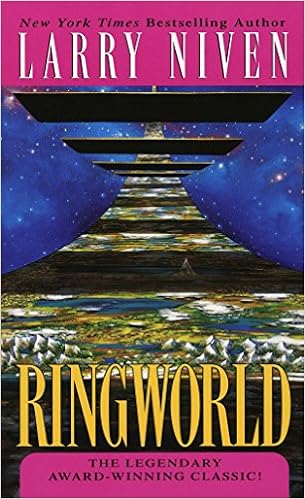|
Larry Niven, Ringworld (Del Rey, 1970) Honestly, who hasn't heard of the legendary Ringworld? Larry Niven's wildly popular book stormed out of the gates, wowing readers and picking up both the Hugo and Nebula awards for best novel. And how could it not? The central premise -- an artificial world, a ring a million miles wide and 600 million miles long, spinning to create its own artificial gravity and holding oceans, atmosphere and teeming life on its inner surface -- was so bold, so brilliant, so audacious that it makes you wonder why no one ever thought up the concept before Niven did.
The cast of characters is promising enough: Louis Wu is a human several hundred years old who's jaded, having seen it all; Nessus is a cowardly Puppeteer, bordering on insanity; Speaker-To-Animals is a Kzin, an arrogant, violence-prone feline alien; and Teela Brown is essentially a vapid, spoiled human bimbo, who would naturally be played the equally vapid Denise Richards were this ever made into a movie. This unlikely crew is gathered by Nessus for some obscure mission of great importance to the long-vanished Puppeteer race. In fact, to stress its importance, Niven spends the entire first third of the book assembling this crack exploration crew, all the while keeping their destination a coy little secret (nevermind the fact the book is titled -- SURPRISE! -- Ringworld). The crew flies to the mysterious Ringworld. They argue about what to do when they get there. They putter around, moving from place to place in order to give Niven a chance to show off all sorts of neat little details he came up with in order to make Ringworld function. Then they crash on Ringworld, and have to set out in search of help to get their spacecraft aloft again. Ringworld, it turns out, is covered with vegetation very similar to that of Earth! Ringworld, it turns out, is populated by human beings! Ringworld, it turns out -- all 600 million miles of it -- has reverted into a primitive tribal barbarism! This reader, it turns out, flung the book across the room calling Bullshit! Of all the possibilities Niven had before him, this direction was quite possibly the worst way he could've gone. Ringworld is an exotic, alien locale and this novel's reason for being is to give us a tour of that exotic, alien locale, in much the same way as Lord of the Rings existed to give us a guided tour of the lavishly constructed Middle-Earth. What does Niven give us? Pre-industrial humans, left on Ringworld by the mysterious, never-seen Engineers. Earth-like plants, Earth-like geography, albeit on an absurdly large scale -- one mountain in particular is practically as large as the Earth itself. We get floating castles and ruined cities, things that come a dime a dozen in cheap fantasy trilogies. Niven works on such a broad canvas, tossing gargantuan geographic features around so casually (several oceans observed in passing are wide enough to hold Jupiter several times over) that the scale and grandeur is utterly lost, beyond the reader's ability to grasp. The one bit that I found interesting, killer metallic sunflowers, was glossed over quite abruptly. And this expedition, disturbingly, happily goes about its journey by laying waste to large swaths of the indigenous population, lasering them, dropping buildings on them or (in the case of the Kzin) dismembering them in savage, bloody ways. And none of them ever really stop to say "Hey, we're the intruders here. These people were living happily until we showed up pretending to be gods and smiting them mightily." By far the most annoying part of the book centers around the girl, Teela Brown. Luck, Niven would have us believe, is a genetic ability that can be enhanced due to natural selection. Strange things happen, all because it would be lucky somewhere down the line for Teela. If it weren't so ludicrous, it might be funny. A concept as absurd as that belongs in a Douglas Adams farce, not something akin to hard SF. Indeed, all this "genetic luck" does in the book is serve as a plot device, a cheap way of explaining away any and all awkward coincidences the author deemed it necessary to include to move the narrative forward. Such a trick worked well for Fred Saberhagen in his Book of Swords series, where he used the luck sword Coinspinner to great effect -- but the Book of Swords stories were pure fantasy and didn't masquerade as science fiction. Ringworld is a cluster of ideas -- some brilliant, some bogus -- masquerading as a novel. Perhaps Niven addressed these problems in his sequals, Ringworld Engineers and Ringworld Throne, but I'll never know. If Ringworld convinced me of one thing, it's that I don't want to waste one more minute slogging through this nonsense. 
|
 Rambles.NET book review by Jayme Lynn Blaschke 28 November 1999 Agree? Disagree? Send us your opinions!  



 |

